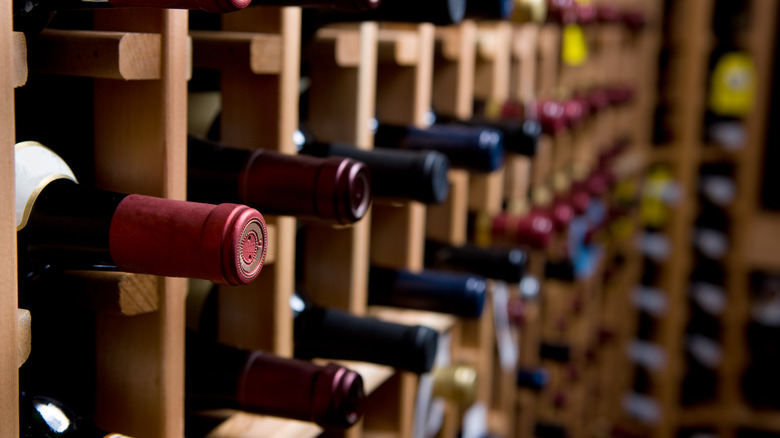The Biggest Mistake You're Making When It Comes To Storing Wine
Maybe you have a stockpile of gifted bottles left over from the holidays, or perhaps you went on a little shopping spree recently. However you got them, it's a nice feeling to have a selection of wine at home, ready for impromptu gatherings (or when you're just looking for something to pair with your favorite reality show), even if it's not exactly a full-blown wine cellar. Just be sure to do it properly if you're storing wine at home — otherwise, you risk making a classic wine mistake that could ruin a fantastic bottle.
One absolute must when it comes to wine storage is to ensure you're resting each bottle on its side, not standing it up like a display. Sure, it can be convenient to store bottles upright so you can easily see the labels — like most wine stores do — but if that bottle stays standing up for months or even years, it could age more quickly than it ought to and degrade in quality. The culprit? The cork.
Many wine professionals say that wine is best stored on its side so that the inside end of the cork is always in contact with the wine. This is meant to prevent the cork from drying out, which can allow oxygen to sneak into the bottle and prematurely age the wine, in extreme cases causing it to turn.
Keep your cork wet
A dried-out cork is a problem for a couple of reasons. One, as you may know from personal experience, is that a dry cork may crumble when you go to open the bottle. Having to decant little bits of cork out isn't the end of the world, but it's still a pain and ideally avoided. The bigger problem that dry corks pose is oxidation — allowing the wine to come into contact with oxygen in the atmosphere. A wine oxidized past its prime will lose the robustness of its flavors and aromas, and may start to taste metallic or excessively acidic.
The one exception to this is if you're storing a partially drunk bottle of wine. When a bottle isn't completely full, storing it on its side rather than upright increases the wine's surface area, thus exposing more of it to the oxygen trapped inside the bottle's empty space. If you're not going to finish a bottle right away, seal it back up and store it upright in the refrigerator — or better yet, transfer the remaining wine to a smaller, airtight container like a mason jar to mitigate oxidation.
Drops of doubt
While storing bottles on their side is the prevailing wisdom you'll hear from virtually every wine magazine, sommelier, or enthusiast, it's not totally uncontested. Some research suggests that the inside end of corks aren't at risk of drying out at all, and it's really the other storage features (temperature, humidity, light) that you need to worry about.
Whether you want to stick with the traditional advice or defy it and store your bottles upright, there's still a consensus that however the bottles are oriented, they should be kept in a consistently cool (but not cold) environment, with moist air and minimal sunlight. (The ideal conditions are between 45 and 65 F and between 50% and 80% humidity — but minor deviations won't ruin a wine, especially if you're not planning to store it for several years.) Basements tend to fit the bill, but if you don't have one, just keep your wine in a pantry or somewhere else that's dark and, since temperature is key when storing wine, insulated from major temperature fluctuations. If the air in your storage area is on the dry side, you can place a sheet pan full of water nearby to help add some moisture to the atmosphere.


